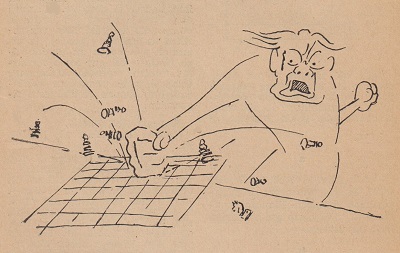
Edward Winter
(2004, with updates)

Lances humorísticos de ajedrez by Hans Cohn (Guatemala, 1938), page 32

The Chess World, 1 January 1933, page 157
Chess with Violence by Hal McCarney, published in Canada in 1992, is ‘a work of fiction’ with the subtitle ‘Rum running in the 1000 Islands’ and has nothing to do with chess. However, the game’s literature features a number of lurid tales of alleged violence by masters, and it may be wondered what factual content they have.
The most notorious story is of a brawl between Steinitz and Blackburne. In an article published on pages 176-177 of the March 1913 Chess Amateur and pages 132-135 of the June 1913 American Chess Bulletin Robert J. Buckley wrote of Steinitz:
‘Enraged he became sub-human. During the Paris Tourney of 1867, in a trifling dispute, he spat on his opponent, an English player, who promptly knocked his head through a window, the subsequent extrication a sight for the gods.’
With minimal rewriting, Harold C. Schonberg availed himself of Buckley’s article on page 96 of Grandmasters of Chess (Philadelphia and New York, 1973):
‘When enraged he became subhuman. During the Paris Tournament of 1867, in a trifling dispute, he spat on his opponent, a British player – some say it was Blackburne – who promptly knocked his head through the window.’
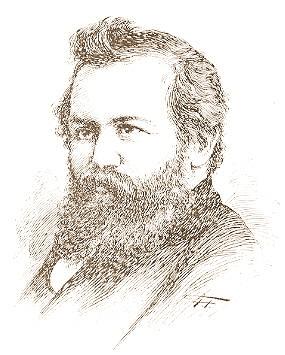
Wilhelm Steinitz
Schonberg’s book was discussed, by no means respectfully, in CHESS in 1974-75, and on page 104 of the January 1975 issue Wolfgang Heidenfeld quoted the above passage and commented:
‘This may, or may not, be true. But in order to lend substance to a thin story which might otherwise be disbelieved, the author inserts his comment “some say it was Blackburne”. This makes it interesting – or does it? Bad luck, chum: Blackburne did not even play in Paris, 1867.’
By chance, the following issue (February/March 1975, pages 153-156) had an article by Paul Hugo Little on Baden-Baden, 1870 which included the following on page 154:
‘A few years later, at a City of London Chess Club game, it was said that Blackburne so angered Steinitz that he spat at the “Black Death”, who promptly knocked his head through a window.’
(And so the present account is already at the third occurrence of ‘promptly’, a favourite word of the anecdotally inclined.)
On page 195 of the April 1975 CHESS a reader, D.J. Fisher, observed:
‘In a vitriolic attack on the unhappy parvenu chess historian, Schonberg, Heidenfeld refutes the story that Steinitz spat at Blackburne at Paris in 1867, on the basis that Blackburne was not in Paris at that time. However, the “distinguished” Paul Hugo Little in the following month’s CHESS tells the same story, identical in choreography but now set in London, some time after 1870. Why does chess invite confused and shoddy scholarship, with little discrimination between fact and fancy and little checking of sources?’
The May/June 1975 issue (page 244) carried P.H. Little’s reaction:
‘I note in your April issue D.J. Fisher’s letter on “apocryphal tales” and feel impelled to answer his charge of “shoddy scholarship”. It is very true that Schonberg’s book wrongly cites the affaire Steinitz-Blackburne as taking place at Paris, 1867, where Blackburne did not play. However, if Mr Fisher will examine the earlier volumes of Steinitz’s own short-lived International Chess Magazine and carefully read the monologuistic letters, he will find, however obscure, a reference to that episode, wherein Steinitz irately accuses the “Black Death” of being a bullying man-handler. To the best of my recollection – and I had seen an earlier reference some 40 years ago in another equally defunct periodical – Blackburne made an insulting remark, Steinitz spat towards him – though not necessarily hitting him – and Blackburne smashed him in the face with his fist. It happened at the City of London Chess Club.’
And that was that. When Schonberg’s Grandmasters of Chess appeared in paperback (see page 80 of the 1975 Fontana edition), Paris was out, London was in, and that other faithful stand-by word, ‘once’, was enlisted:
‘When enraged he became subhuman. Once, playing at a London club, he got into a dispute with a British player – some say it was Blackburne – and spat on him, promptly getting his head knocked through the window.’
In the ‘revised and updated’ edition of Schonberg’s book, published in New York in 1981, the passage (see page 96) turned out to be a hybrid version, with Buckley’s word ‘subhuman’ also gone:
‘When enraged he lost control. Once, in a London club, he got into a dispute and spat on his opponent, a British player – some say it was Blackburne – who promptly knocked his head through the window.’
Page 113 of The World of Chess by A. Saidy and N. Lessing (New York, 1974) contained another ‘is-said-to-have’ version, although with the adjective ‘enraged’ applied to Blackburne, not Steinitz:
‘In 1870 [sic – 1876 would be correct] he trounced Blackburne, 7 to 0. The British master, who was fond of the bottle, is said to have become so enraged at one point that he threw Steinitz out of a window.’
The story naturally continued to spread, and not just in chess literature. Page 222 of The Sports Hall of Shame by Bruce Nash and Allan Zullo (New York, 1987) stated:
‘During the Paris Tournament in 1867, he blew up over a trivial remark made by his British opponent, Joseph Blackburne. In a rage, Steinitz spat in his face. Blackburne, who was no white knight himself, promptly picked up the short, squat megalomaniac and threw him right out the window.’
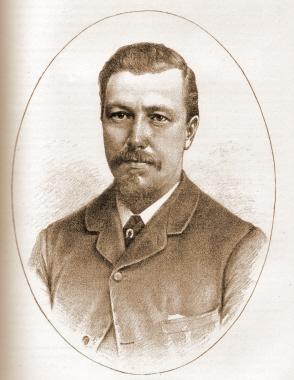
Joseph Henry Blackburne
It is high time we examined what is available in nineteenth-century sources about these contradictory claims of expectoration and defenestration.
A virulent attack on Steinitz (‘Quasimodo’) on pages 264-265 of the May 1889 issue of L. Hoffer’s Chess Monthly included the following passage:
‘Another reason why we do not follow the advice of friends to treat Quasimodo with silent contempt is that he is not so charitable himself as to expect it from those he constantly maligns. Did he hold out his left cheek when Blackburne gave him a smack on the right, both here at Purssell’s and during the Paris Tournament at the hotel? He did not take the chastisement meekly, but tried to retaliate with his cane, which Blackburne broke in twain and threw in the fire; and did not he attempt, in his impotent rage, like a fish-fag, to spit into his adversary’s face, just as he is doing now in the International?’
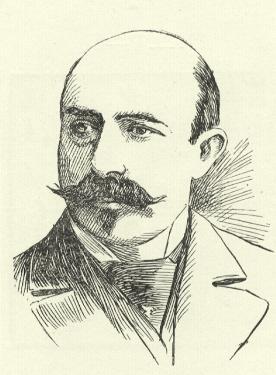
Leopold Hoffer
Steinitz responded on pages 332-333 of the November 1889 International Chess Magazine (addressing Hoffer as ‘Dreckseele’):
‘Allow me to tell you, Dreckseele, that you lie again deliberately with your usual Long Champs lying insolence, when you talk of Blackburne having merely smacked my right, “both here at Purssell’s and during the Paris Tournament at the hotel”. Here is my version, Dreckseele. Blackburne suffered some 22 or respectively 11 years ago even more frequently from fits of blackguardism on the J.Y. Dreck principle, which you and all your Dreck chums worship, than he does now. And on one occasion at Purssell’s about 1867, in a dispute between us, he struck with his full fist into my eye, which he blackened and might have knocked out. And though he is a powerful man of very nearly twice my size, who might have killed me with a few such strokes, I am proud to say that I had the courage of attempting to spit into his face, and only wish I had succeeded, Dreckseele. And on the second occasion, in Paris, we occupied adjoining rooms at the same hotel, and I was already in bed undressed when he came home drunk and began to quarrel, and after a few words he pounced upon me and hammered at my face and eyes with fullest force about a dozen blows, until the bedcloth and my nightshirt were covered with blood. But at last I had the good fortune to release myself from his drunken grip, and I broke the window pane with his head, which sobered him down a little. And you know well enough too, Dreckseele, if any confirmation of anything I say were needed, that the same heroic Blackburne performed a similar act of bravery on a sickly young man, Mr Israel, who died some years afterward, and whom he publicly gave a black eye at Purssell’s during his first match with Gunsberg. And you also know, Dreckseele, that this gallant Blackburne struck in a similar manner, publicly, in the City of London Chess Club, the secretary, Mr Walker, as nice a little gentleman as I ever met, who was even a head and shoulder shorter in stature than myself, and who has also, I am sorry to learn, died since. And I may tell you, moreover, Dreckseele, that this brave Blackburne, whose blackguardly fisticuff performances you want to glorify at my expense, has never to my knowledge struck a man of his own size, unless it were in the case of an assault on board ship, during his journey to Australia, for which he was fined £10 at the police court, on his landing in Melbourne. And if your valiant Blackburne, Dreckseele, is not thoroughly ashamed of such performances by this time, he would deserve to be spat upon by any gentleman, just as I spit upon you now, Dreckseele … And in my opinion, Dreckseele, poor Blackburne cannot redeem himself otherwise than by giving you a sound thrashing, Dreckseele, for having without his authority, I assume, dragged his name and a falsified account of his conduct toward myself into the controversy, thus compelling me to give my version of his performances, most reluctantly, I must say, for I am thoroughly ashamed of it on behalf of chess in general, but in no way, Dreckseele, on my own account personally.’
There are thus two separate incidents, and it will be noted from Steinitz’s account that it was Blackburne, not he, who came into violent contact with a window. Moreover, his reference above to ‘11 years ago’ indicates that the Paris tournament under discussion was in 1878, not 1867. Although, unlike Blackburne, Steinitz did not participate in Paris, 1878, he was present. Indeed, he appeared in the Paris, 1878 photograph given on page 38 of Fred Wilson’s A Picture History of Chess (New York, 1981).
(3195)
Newspaper reports on a Blackburne incident referred to above were given in C.N.s 6437 and 6440.
Alekhine has been the subject of two main accusations of violent action after losing a game: a) destroying hotel furniture and b) throwing his king across the tournament hall. These were discussed on, respectively, page 156 of Chess Explorations and pages 279-280 of Kings, Commoners and Knaves.
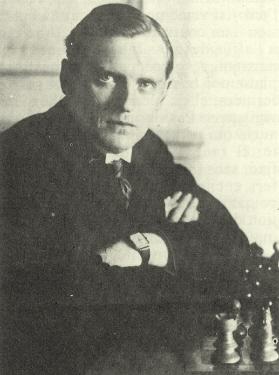
Alexander Alekhine
Page 3 of the January 1986 APCT News Bulletin had the following affirmation about Alekhine v Yates, Carlsbad, 1923:
‘Rumor has it that after losing this game, Alekhine went back to his hotel room and smashed the furniture.’
As reported in C.N. 1129, we requested a source for this (‘a contemporary reference, naturally, and not a Horowitz or Reinfeld potboiler’), but the February 1986 issue of the Bulletin (page 41) merely offered the following passage from page 128 of Reinfeld’s Great Brilliancy Prize Games of the Chess Masters (New York, 1961):
‘The story is told that one day after losing a game in the formidable Carlsbad tournament of 1923, Alekhine went back to his hotel room and smashed every stick of furniture. The following game [Alekhine v Yates] may well be the one that made him so rambunctious, for his defeat cost him clear first prize in the tournament.’
C.N. 1129 then pointed out that Alekhine’s loss to Yates was the second of three defeats at Carlsbad, 1923. Both Reinfeld and the APCT News Bulletin had overlooked that it was played as early as round seven (out of 17 rounds) and therefore did not ‘cost him clear first prize’. We added that the incident was often ‘rumoured’ to have occurred after Alekhine’s loss to Spielmann in the same tournament.
And there the matter was left. (As noted in C.N. 1276, our second letter to the APCT News Bulletin was neither published nor acknowledged.) But now we note that 11 years before Reinfeld’s book appeared (i.e. in Chess Review, May 1950, pages 136-138) he co-authored with Hans Kmoch an article on Carlsbad, 1923 which stated:
‘Alekhine was as furious as only he could be when he unexpectedly lost a game in his palmy days. On such occasions, rare though they were, he was filled with savage anger, so much so that he ran the danger of getting a stroke if he did not have an adequate outlet for venting his rage. Having resigned his game to Spielmann, he stormed back to his room at the Imperial (the best hotel in Carlsbad) and smashed every piece of furniture he could get his hands on.’
It may be wondered why Reinfeld was later to speculate, when writing solo, that the game in question had been against Yates.
Another article by Kmoch and Reinfeld in the 1950 Chess Review (February issue, page 55) said that at the end of his game against Grünfeld at Vienna, 1922 ‘Alekhine resigned – by taking his king and throwing it across the room’. Kmoch was a participant in the tournament.
Such accounts are insufficiently vivid for the likes of Harold C. Schonberg, who decided, on page 27 of Grandmasters of Chess, to make the throwing more dramatic and the destroying more frequent:
‘Alekhine once resigned, frantic with rage and frustration, by picking up his king and hurling it across the room, nearly braining a referee in the process. (Tournament pieces are weighted with lead; they can be dangerous weapons.) Alekhine would also relieve himself after a loss by going to his hotel room and destroying the furniture.’
In Grandmasters of Chess Schonberg exhibited scant concern for facts or fairness, and on page 220 he even professed that Alekhine was ‘as amoral as Richard Wagner or Jack the Ripper’. If morality is the issue, Schonberg’s act of writing such a thing is worth a moment’s contemplation.
(3196)
Mark Nieuweboer (Moengo, Surinam) refers to an article on Spielmann by Hans-Wilhelm Fink on pages 111-149 of Rudolf Spielmann Portrait des [eines] Schachmeisters in Texten und Partien by Michael Ehn (Koblenz, 1996). Pages 127-128 quote most of what Hans Kmoch wrote on pages 61-62 of his book Die Kunst der Bauernführung (Berlin-Frohnau, 1956). The relevant part of Kmoch’s book is the final paragraph of that section:
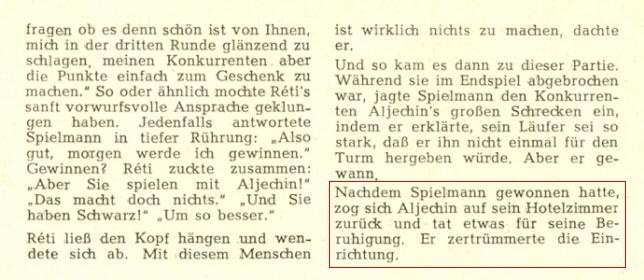
The passage in question (over 60 lines) is absent from the English edition of Kmoch’s book, Pawn Power in Chess (New York, 1959). Our correspondent asks whether Kmoch was present during the Carlsbad, 1923 tournament.
We add that Michael Ehn’s book on Spielmann is admirably researched.
(5013)
From an article ‘Unconventional Surrender’ by Hans Kmoch and Fred Reinfeld on page 55 of the Chess Review, February 1950:
‘Alekhine hit on still another way of resigning during the Vienna tournament of 1922. ... When he saw that Grünfeld had sealed 54...Q-B6 (the strongest move), Alekhine resigned – by taking his king and throwing it across the room.’
From page 4 of Why You Lose at Chess by Fred Reinfeld (New York, 1956):
‘Hans Kmoch and I once surveyed [methods of resigning] in an article called “Unconventional Surrender”. We recalled that Alekhine, who was unequaled as a desperate fighter in disheartening situations, occasionally [our emphasis] resigned by picking up his king and hurling it across the room.’
Notwithstanding the word ‘occasionally’, the Kmoch/Reinfeld article had not suggested that the conclusion of the Alekhine v Grünfeld game was other than an isolated incident.
As noted above, Kmoch was a participant in Vienna, 1922, but does any other source corroborate the claim about Alekhine which Kmoch made nearly three decades later?
(5843)
The above C.N. item was entitled ‘The anecdotalist’s plural’.
From page 12 of How to Play Chess Like a Champion by Fred Reinfeld (New York, 1956):
‘... Alexander Alekhine was not only the greatest of the world champions; he was also the greatest chess artist of all time. He was a man of extraordinary nervous energy who had been known to fling his king across the room or smash furniture on the rare occasions when he lost. A rotten sport, maybe, but he took his chess very hard.’
A cartoon feature by C.J. Theriat from page 488 of Harper’s New Monthly Magazine, February 1888:
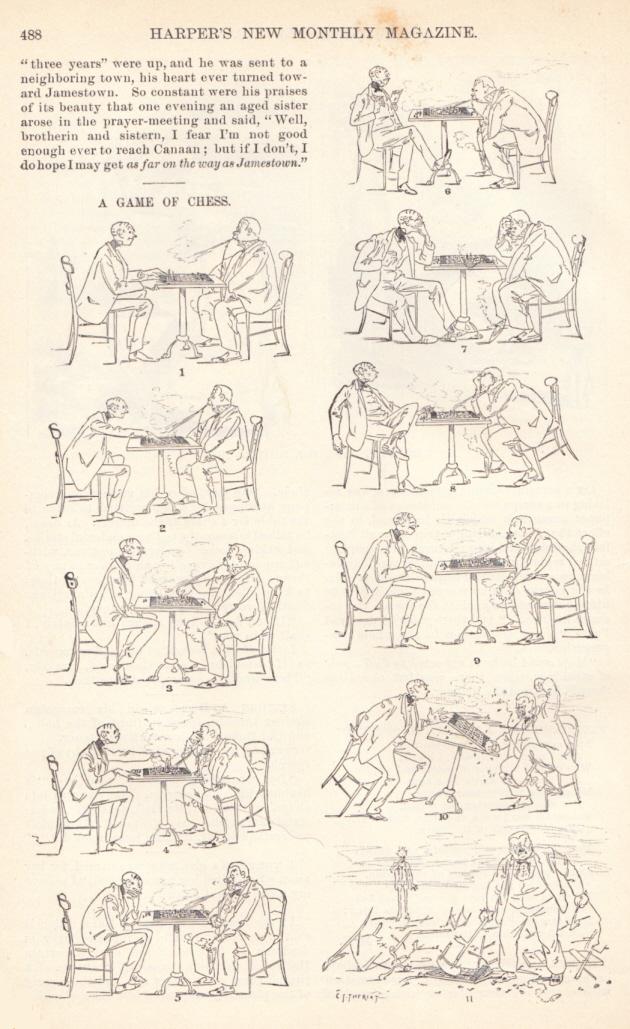
(7449)
‘Curious, but true chess stories’ are promised on the front cover of Fried Liver & Burning Pants by “Coach Jay” Stallings, an execrable 89-page book published in 2012. To quote from pages 19-21:
‘Chess, too, has taken its toll on the sanity of men for many years. Alekhine was a great chessplayer, but his tendency to sometimes yell and knock over the chess pieces after a loss prompted players and fans to keep their distance when Alekhine’s opponent was on verge of victory ...
... At the Carlsbad tournament in Czechoslovakia (now known as the Czech Republic) in 1923, Alekhine had worked hard, as usual, and with only two rounds remaining was comfortable in his familiar position at the top of the standings. He fully expected to stay there; after all, he had spent a lot of time carefully preparing, as he always did. And then, something for which he had not prepared happened – he lost! He had abandoned a chance for a draw and was pushing for a win when his opponent (Frederick Yates) used his queen and bishop to take advantage of Alekhine’s exposed king. Alekhine’s frustration was enormous, but, as good sportsmanship requires, he politely shook his opponent’s hand and congratulated him on his victory. Then, Alexander Alekhine calmly walked back to his hotel room and destroyed every piece of furniture in the room!’
(8559)
From page 67 of Idle Passion by Alexander Cockburn (New York, 1974), regarding Alekhine:
‘He would sometimes hurl his king across the room. On occasion he would smash the furniture. Games generated an enormous tension in him.’
C.N. 8256 mentioned in passing that the word ‘treatise’ is no longer fashionable in chess book titles. The most marked change in vocabulary may be in works for children (or nowadays, more commonly, ‘kids’). Half a century or so ago, young newcomers to the game received solid tutelage from The Chess Apprentice by R. Bott and S. Morrison (London and Glasgow, 1960), but such a title would seem unthinkable today, as would, for instance, Instructions to Young Chess-Players by H. Golombek (London, 1958).
A number of titles ostensibly for older players reflect a trend towards fantasy violence, an example being The Chess Terrorist’s Handbook by L. Shamkovich (Macon, 1995). It was dedicated to Mikhail Tal (‘The Greatest Chess Terrorist!’).
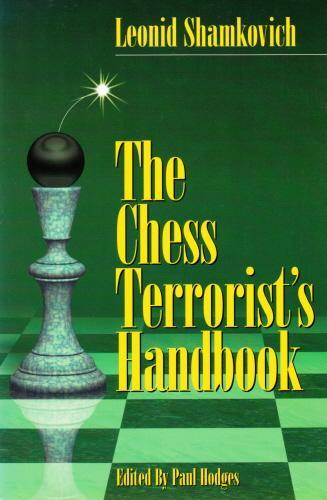
Then there are the productions of Thinkers’ Press, Davenport, such as The Chess Assassin’s Business Manual by Bob Long (2008) ...
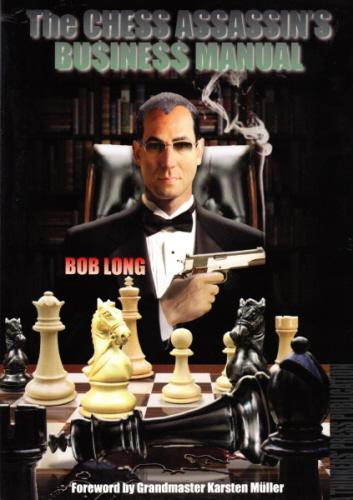
... and a series of brief monographs including, to quote the covers, Alekhine The Executioner (2011) and Keres Machine Gunner (2012) or, to quote the title pages, Alexander Alekhine The Executioner and Paul Keres Machine Gun Keres.
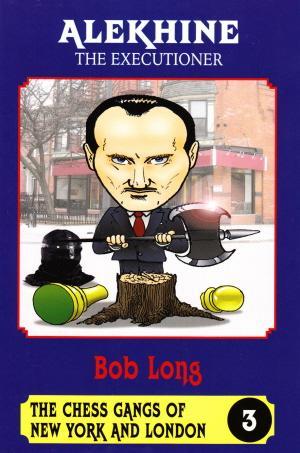
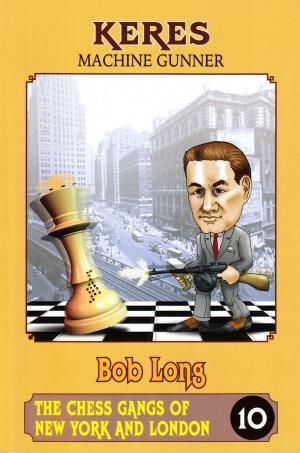
A sociological study could be written on the evolution of chess book titles and covers. Doctorates have been awarded for less.
(8286)
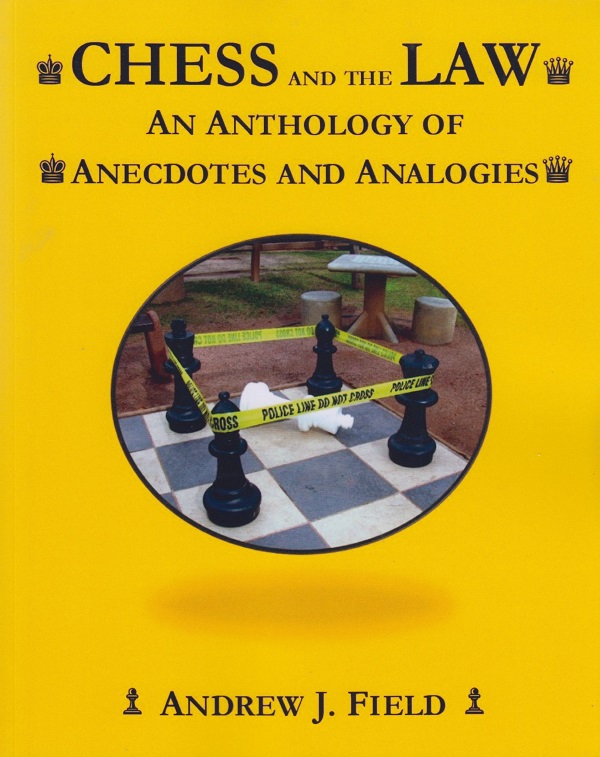
The hundreds of entries in Chess and the Law An Anthology of Anecdotes and Analogies by Andrew J. Field (‘Amazon Fulfillment’, Wrocław, 2019) range from a brief paragraph on a minor court-case to four pages on Norman Tweed Whitaker and nine on William Henry Russ. An unnumbered introductory page states that the book ‘surveys the many interesting and unusual ways that the game of chess has intersected with the practice of law in the United States’ and warns that ‘this book is not appropriate for children’. Many violent cases are discussed.
(11681)
To the Chess Notes main page.
To the Archives for other feature articles.
Copyright: Edward Winter. All rights reserved.